Abstract
This study investigates the impact of incorporating Juncus fibers (JF) into compressed earth blocks (CEBs) stabilized with varying Portland cement contents, aiming to enhance local construction materials’ performance and reduce housing costs. CEB composites were produced with soil stabilized using different cement contents (4%, 8%, and 12% by weight) and JF reinforcement (0 to 0.2% by weight), compressed at 10 MPa with a hydraulic press. After 28 days of drying, the CEBs underwent diverse experimental characterizations to assess their physical, mechanical, thermal, and durability properties. The results revealed that incorporating JF led to a reduction in unit weight, ultrasonic pulse velocity (up to 36%), and dry compressive strength (approximately 17%). Higher fiber content correlated with increased water absorption and an increased capillarity coefficient. Thermal conductivity analysis indicated improved thermal performance, decreasing from 0.4350 W/m·K (12% cement without fibers) to 0.2465 W/m·K (4% cement with 0.2% JF). Despite the decrease in mechanical strength, CEBs with lower cement (4%) and higher fiber content (0.2%) demonstrated satisfactory durability (abrasion and erosion) and thermal insulation properties. This research suggests the potential of this material as a promising composite for the building materials industry. The findings contribute valuable insights into sustainable construction materials and have implications for cost-effective housing solutions.
1. Introduction
Countries have committed in the Sustainable Developments Goals (SDGs) to develop actions related to the building sector, namely developing sustainable cities and communities, combatting climate change, and promoting affordable and clean energy. The building industry has become the main obstacle on the road to achieving these global goals and protecting our planet [1]. The construction sector is responsible for up to 33% of CO2 emissions, 40% of global energy use, and 40% of the entire waste production [1]. Such situations have motivated researchers around the globe to study the potential of stabilized soil using affordable alternatives with a low environmental impact [2]. Meanwhile, the scarcity of affordable housing around the world is significantly noted. More than 50 million house units are needed in Africa to face the housing shortage. Efforts are being made to encourage the construction of new houses for low-income families by using local building materials. Earthen buildings have been used for millennia and even today, approximately 35% of the world’s population live and work in earthen houses [3,4]. Earth is an eco-friendly, low-cost, widely available building material that can help to promote living in comfort and decrease environmental issues.
Compressed earth blocks (CEB) represent a widespread recent technique of earth construction discovered in the 1950s. They are considered as an evolution of old adobe, since the production process follows the same steps, only the compaction energy is increased. Furthermore, stabilization techniques (mechanical, physical, and chemical) have been used to improve their strength and durability. Nevertheless, earth blocks usually suffer from a lack of durability, low resistance to erosion, and low strength [5]. Many collapses have occurred after natural hazard disasters (e.g., monsoons, floods, storm surges, and tsunamis) in some regions around the world, which represents a major hindrance to the SDGs, and has led to the utilization of burned blocks and concrete bricks [5]. However, due to the low thermal performance, higher cost, and especially the higher environmental impact of these materials, renewed interest has been focused on environmentally friendly healthy earth-based building materials [6,7,8,9]. Many studies on CEBs have proved that the incorporation of Portland cement and additives to earth blocks allows for an increase in their mechanical properties and resistance to water [5,10,11,12,13,14].
Many authors have focused on the properties of stabilized CEBs [11,13,15,16,17,18,19,20,21]. The compressive strength of CEBs is influenced by the test method used [11] and increases with the increase in cement content [15]. The investigation of the influence of the curing period in CEBs stabilized with cement has shown that 28 days of curing provides the largest value of compressive strength [16]. Other research studies [6,7,8,9,11,12,13] have been carried out on cement as a widespread and recent chemical stabilizer, usually used with fibers and other additives. Nevertheless, the use of Portland cement enhances the embodied energy of the stabilized CEBs owing to the energy demand during the production of cement. Moreover, the use of chemical stabilizers did not improve the ductility, toughness, and tensile strength [22,23]. It also generates the problem of recyclability due to the chemical reaction that transforms soil construction material into artificial stones [24]. A number of works have been focused on the effect of chemical stabilization on long-term strength and water absorption [14]. They have found that compressive strength increases and water absorption reduces over time. Bahar et al. [25] noticed that a mix of mechanical compaction and chemical stabilization up to a certain level could be the best method of stabilizing the blocks, providing good compressive strength and better durability at a reasonable cost.
Currently, due to the shortage of available energy sources and ongoing increases in energy consumption, energy costs are on an upward trajectory. Consequently, it is crucial to find alternatives to reduce energy use and price. During recent years, the addition of fibers to soil blocks as reinforcements or replacements for other constituents has increased enormously, mainly for political, environmental and economic reasons. Numerous types of natural fibers have been incorporated to soil–cement blocks to develop building material composites with great thermal performances [15,16,17,18,19,20], which result in reducing heat transmission inside buildings, which could lead to decreased energy use of constructions utilities, including air conditioners. Others studies concerning thermal properties have highlighted that a large value of thermal conductivity is observed for bricks stabilized with cement [21]. Also, the increase in cement and lime content increases thermal conductivity [15,26].
The future of “green composites” will be natural fiber-reinforced biopolymer materials, which have the potential to tackle sustainability challenges including environmental pollution and the shortage of natural resources. Traditionally, since ancient times, natural fibers have been incorporated into earthen building materials to improve composite performance, including ductility, toughness, tensile strength, and durability, as well as increasing its strength [5,22,23,24] while reducing shrinkage and cracks. Due to their capacity to substitute synthetic fibers, and because of their global abundance, plant fibers have received specific interest for their application in building materials [22,23]. Furthermore, some studies have concluded that increasing the fiber content leads to a decrease in the thermal conductivity of CEBs [15,16,27,28,29]. According to the literature [30], the mechanical strength is improved with the increase in fiber content due to the matrix’s ability to glue the grains and fill the pore network, with low unit weight. Finally, fibers decrease the earth composite density, which has a number of benefits, including increased earthquake protection by reducing inertial forces and reduced thermal conductivity [31,32,33].
In the context of global warming, the cracking phenomenon due to desiccation that has already occurred in different soils is predicted to further emerge with high frequency [34,35]. Ran et al. used micron-sized X-ray computed tomography (Micro-CT) to investigate the dynamic evolution of drying-induced cracks and permeability in granite residual soil (GRS) over time (0 to 120 h). Their results showed that the average area/porosity ratio increased as the drying process progressed and that connected cracks propagated rapidly through the samples, while isolated cracks remained relatively unchanged. Moreover, the pore-diameter distribution of GRS indicated that the propagation of connected cracks was a key factor influencing soil cracking. The simulated permeability values were generally consistent with the measured values, indicating the accuracy of the seepage models. Both the experiments and numerical simulations showed that the desiccation process had a significant impact on the hydraulic properties of the soils [36].
This work is based on the investigation of the feasibility of combining Portland cement as a stabilizer and Juncus fibers (JF) as a reinforcement for the production of compressed earth blocks in order to improve their properties. Portland cement was used as a stabilizer of the CEBs, at proportions of 4%, 8%, and 12% by weight. The JF reinforcement were incorporated at different proportions, specifically 0%, 0.05%, 0.1%, 0.15%, and 0.2%. Experimental characterization was conducted to investigate the properties of the resulting CEB composites, including the density, ultrasonic pulse velocity, total water absorption, capillarity coefficient, dry and wet compressive strength, thermal conductivity, durability properties (erosion resistance, dry abrasion) and SEM micrographs. To our knowledge, this type of formulation that combines Portland cement as a stabilizers and juncus fibers as a raw material reinforcement to produce compressed earth blocks has not been reported in the literature.
2. Materials and Experimental Testing
2.1. Materials
2.1.1. Earth
The natural soil used in this study as shown in Figure 1 was collected from Ait Massoud area (31°43′54″ N 8°4′49″ W) located 14 km northwest of Marrakesh. The earth was extracted from a layer of 1.5 m under the ground to avoid organic content. This soil was selected because it was used in the past by local builders to construct earthen houses and it is characterized by its abundance and availability in the area. The granulometric size distribution (GSD) was determined following ASTM standard D422 [37]: clay: <0.002 mm; silt: 0.002–0.08 mm; sand: 0.08–2 mm; and gravel: >2 mm. Atterberg’s test (the plastic limit, index plasticity and liquid limit) was performed using ASTM D4318-10 [38]. The methylene blue value of this soil was determined according to the NM 13.1.178 standard [39]. The optimum moisture content for the soil was obtained according to the standard Proctor test [40].
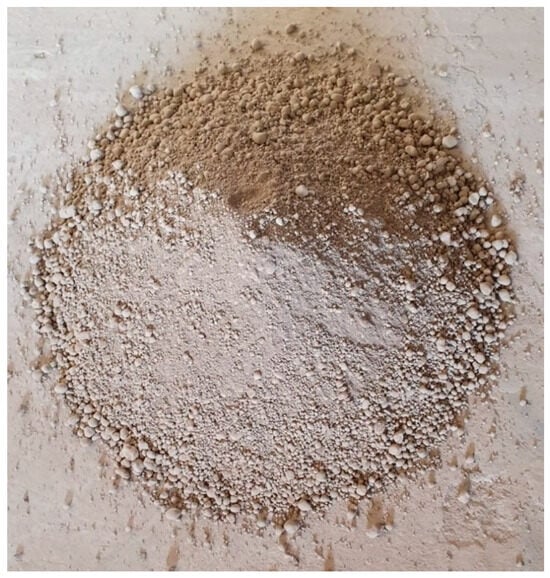
Figure 1.
The earth used in this work.
The chemical composition of the soil was obtained by means of X-ray fluorescence (XRF), and mineral composition was determined using X-ray diffraction (XRD).
The main purpose of the geotechnical characterization of the used soil was to assess its suitability for the production of CEBs.
The properties of the soil used in this study are shown in Table 1a. The soil was constituted of 9.1% clay, 38.4% silt, 25.7% sand and 26.8% gravel. The Atterberg limit test indicated that this soil had a liquid limit WL = 42% and a plasticity index PI = 18%, which agreed within the recommended zone limit by the French Standards XP P 13-901 [41]. It had a dry density ρd = 1.86 g/cm3 and a blue methylene value MBV (g/100 g) = 1.25. Therefore, the soil could be classified as type A1, in close agreement with the XP P 13-901 standard for the elaboration of compressed earth blocks [41].

Table 1.
(a) Geotechnical characteristics of soil. (b) Chemical and mineralogical characteristics of soil.
The chemical composition is shown in Table 1b. The results indicate that the soil consisted essentially of silica, aluminum and calcium carbonate. In addition, it also contained significant quantities of carbon (8%) and magnesium (4%) and a small amount of fluorine (0.87%).
2.1.2. Cement
Portland cement was used in this study (CEM CPJ 45), created by mixing clinker and gypsum with one or more secondary ingredient, such as fillers, pouzzolane, or fly ash, as specified in Moroccan Norm NM 10.1.004. The representative energy dispersive X-ray (EDX) spectra of Portland cement are illustrated in Figure 2. The results indicate the peaks of this binder. It can be noticed from the spectra of EDX that the cement used in this study was mostly composed of oxygen (O), calcium (Ca), carbon (C) and silicon (Si) mixed with traces of aluminum (Al), magnesium (Mg), sodium (Na), sulfur (S), iron (Fe) and potassium (K).

Figure 2.
SEM micrographs/energy-dispersive X-ray (EDX) of cement.
2.1.3. Juncus Fibers
The natural fibers used in this work were from the Juncus acutus plant. Its stems have a length of approximately 1 m, with diameter of 3 mm. It belongs to juncaceae family [42], which grows in humid and wet regions of Africa, South and North America, and Southern and Western Europe [43]. The Juncus acutus plants used in this research (Figure 3a) were harvested from the same region as the soil used in this study. Before their use in the composite, fibers were cleaned with drinking water to remove the presence of any dust and impurities on their surface (Figure 3b). The fibers were dried at 50 °C for 24 h in an ambient temperature laboratory. Then, after drying, they were cut manually into small lengths of between 3 and 5 cm (Figure 3c). Afterward, the fibers were ground using a grind mixer (Figure 3d). The chemical composition of JF is presented in Table 2 [44]. Table 2 also lists the mechanical and thermal properties of the fibers determined experimentally according to ASTM C1557 [45] and a hot disc device, TPS 1500 (Hot Disk AB, Gothenburg, Sweden), respectively. Figure 4 presents the microstructure of Juncus acutus plants by means of scanning electronic micrographs (SEM). The SEM observations indicate that Juncus stems have a hairless and soft appearance with the presence of many dust particles and impurities (wax, fat, etc.) referred to as stomata and located on the surface (Figure 4a) based on longitudinal stem observation. Also, this plant has a cellular structure with pores (Figure 4b), according to SEM of the fiber cross section. The void network morphology of this kind of vegetal fiber is promising for use to develop CEB composites with better thermal performance and a low unit weight.
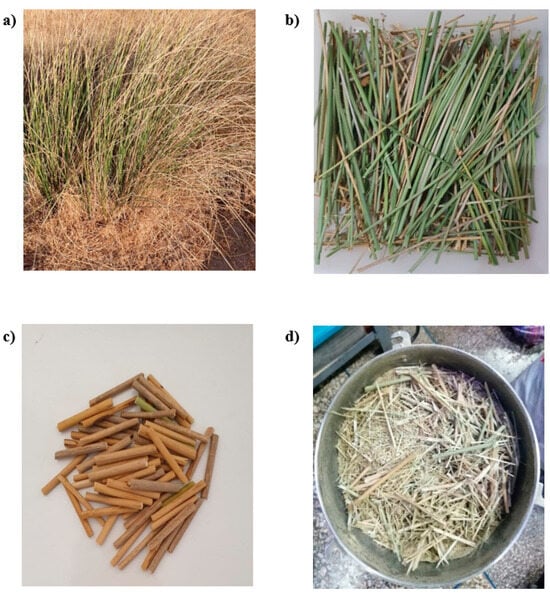
Figure 3.
Juncus fibers: (a) Juncus plant; (b) cleaned fibers with water; (c) cut Juncus fibers; (d) ground Juncus fibers.

Table 2.
Properties of Juncus fibers.
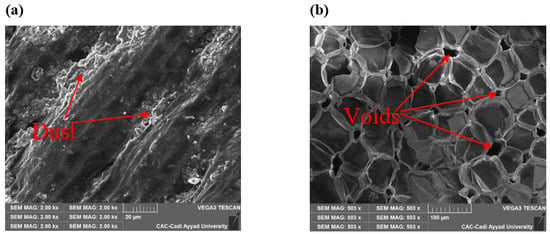
Figure 4.
(a) SEM of a longitudinal section of the stem of a Juncus plant; (b) SEM micrograph of a cross-section of the stem of a Juncus plant.
2.2. Sample Preparation
Different compositions of cement-stabilized earth blocks were prepared with different contents of fibers, as shown in Table 3. The elaboration of specimens consisted of first mixing dry soil sieved at 20 mm and cement using a driven mixer for 20 min, and then gradually adding the dry fibers to the mix until a homogeneous mixture was obtained. Subsequently, water was added gradually at a quantity determined by the proctor test, thus accounting for the water demand for cement to estimate its effect on the stabilization of the earth blocks. Afterward, the mixture was put into steel molds and compressed at a compaction pressure of 10 MPa. After demolding, the drying of the samples took place in normal laboratory conditions at 20 ± 2 °C with a relative humidity of 98% for approximately 28 days until constant weight, and to avoid unwanted waiting, the blocks were cured at 105 °C for 24 h before testing (Figure 5a). The main steps for the production of the CEBs are presented in Figure 5b.

Table 3.
The proportion of mixtures of CEB.
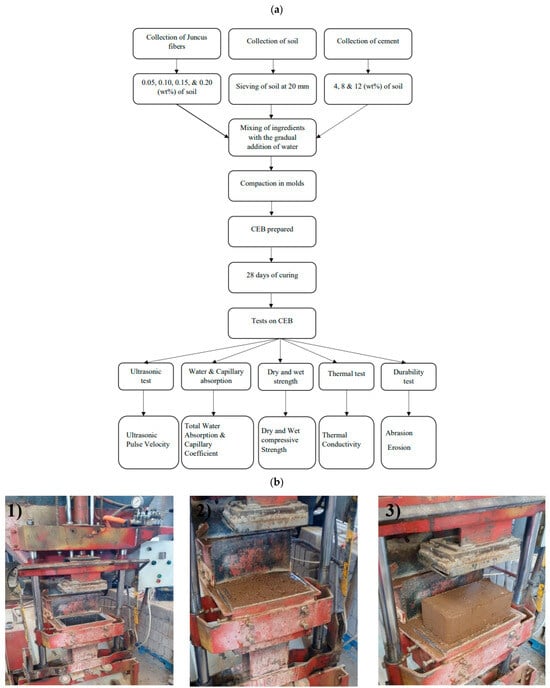
Figure 5.
(a) Schematic procedure for the fabrication and testing of sample blocks; (b) main steps in the production process of the blocks, including (1). after the mixture of the composite, (2). the filling of the mold, and (3). the block after compression.
2.3. Experimental Testing
The physical properties of the CEB samples containing different contents of Juncus fibers, including the dry unit weight, as concluded by means of dimensional measurements and weighing after 28 days of curing, were established.
2.3.1. Ultrasonic Testing
The ultrasonic pulse velocity (UPV) was evaluated on samples as specified in Standard NF P 18–418 [44]. This non-destructive test is based on the propagation of ultrasonic waves in the tested material. Thus, the time transmission was measured using a UPV tester (Figure 6). The velocity of the pulse through the specimen was evaluated using Equation (1):
where V (m/s) is the velocity of the ultrasonic pulse, d (m) is the path length of the sample, and t (s) is the traverse time of the pulse.
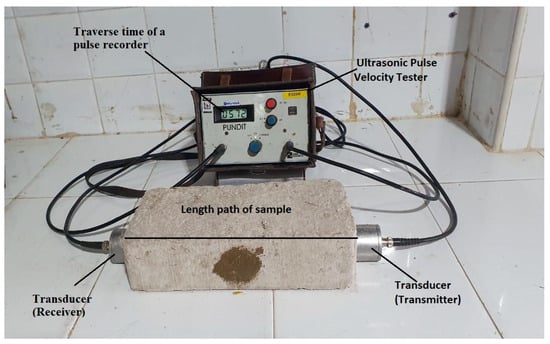
Figure 6.
Ultrasonic pulse velocity tester.
Water Total Absorption
The total water absorption (TWA) measurement was crucial because it provided insights into the composite sensitivity to water and porosity, which is correlated with its engineering properties. This test consisted of immersing blocks in bathwater for different periods, namely 1, 2, 3 and 4 days, and then the TWA was calculated using Equation (2):
where Wh (g) is the wet block weight (after immersion), and Ws (g) is the dry block weight (before immersion).
2.3.2. Capillarity Absorption Test
The capillarity test was conducted in accordance with the XP P 13–901 standard [41]. The main objective of this test was to assess the ability of specimens to absorb water via capillarity (Figure 7). The blocks were weighed before (P0 (g)) being partly immersed in a constant thin layer of 5 mm of water. Then, after 10 min, each block was removed from the water and wiped with a chamois leather cloth, and was weighed again (P1 (g)). Afterwards, the capillarity coefficient assessment was based on Equation (3):
where Cb is the capillarity coefficient (g/cm2 min1/2), S is the area of the immersed bottom surface and t is the water immersion time of the block (min).
- -
- If Cb ≤ 20, the block was considered to have weak capillarity;
- -
- If Cb < 40, the block was considered to have some capillarity.
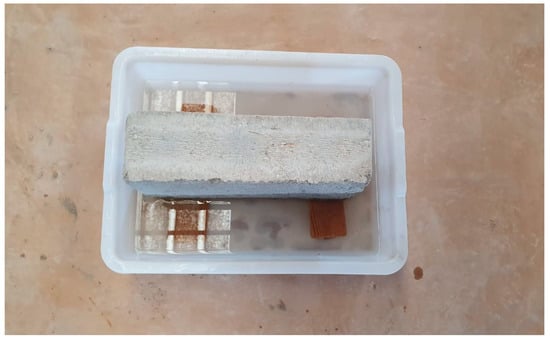
Figure 7.
Capillarity absorption test.
2.3.3. Compressive Strength Test
Dry Compressive Strength
The compressive strength was conducted on three samples from each mixture prepared. This test consisted of applying a compressive load continuously and without jerking to the hardened block until failure (Figure 8). The maximum load supported by the specimen during the test was recorded by using a Hydraulic IGM—France machine with a maximum load capacity of 3000 KN. Tests were carried out at a pressure increase of 0.15 MPa/s until the complete rupture of the specimen. Then, the compressive strength was calculated on each block according to Equation (4):
where (MPa), Fc (N), and S (mm2) are the compressive strength, the maximum failure force and the contact surface between the CEB and plates used in the test, respectively.
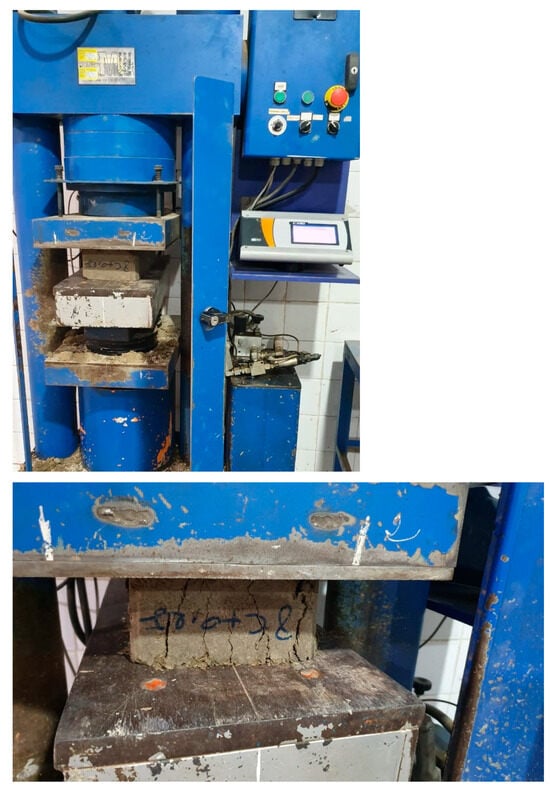
Figure 8.
Compressive strength test.
Wet Compressive Strength
This test was identical to the dry compression test, the only difference being that the test specimens were previously moistened according to the following preparation method:
- We immersed the block completely in water;
- After 2 h of immersion, we removed the block from the water and wiped it with a damp cloth;
- We stored the removed blocks in normal laboratory conditions at 20 ± 2 °C for at least 48 h before testing.
2.3.4. Thermal Properties
The thermal properties of CEB were evaluated using a hot disc device, TPS 1500. The experimental set up is shown in Figure 9. The hot disk sensor served as a heat source and a dynamic temperature sensor during the measurement by sandwiching it between two identical samples 50 × 50 × 20 mm in size. Based on the transient plane source method, we measured the thermal characteristics.
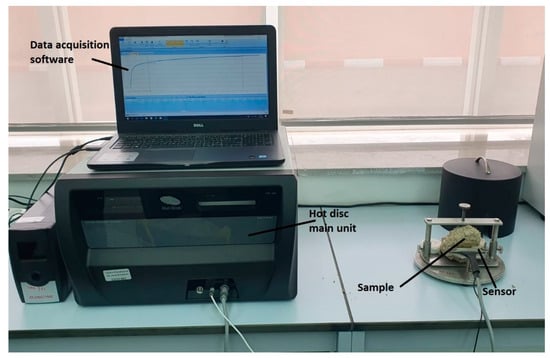
Figure 9.
Thermal property measurement.
2.3.5. Durability Test
The durability of CEB is one of the main aspects that must be considered for any material used for construction.
Dry Abrasion Resistance
The dry abrasion resistance test was performed on the specimens. It was carried out according to the AFNOR, XP P13-901 [41] made for CEBs, by measuring the removed quantity of material from the blocks after 60 back and forth brush sweeps using a steel brush. During the test, the steel brush was used to brush the block surface (roundtrips) once every second for 1 min without exerting any additional vertical force on the brush. Brushing was performed along the entire length of the block, and at least half of the brush surface remained in permanent contact with the surface of the block during the entire test to avoid a cantilever that would put too much stress on the edges of the block. At the end of the brushing, the block was cleaned of the elements that had become detached. A coefficient of abrasion in cm2/g assessment was based on Equation (5):
where is the mass before brushing, (g) is the mass after brushing (g), and S is the brushed surface (cm2).
Erosion Resistance
The erosion resistance was evaluated on the samples to check the effect of water on the CEBs according to the New Zealand Standard NZS 4298 [46]. This test consisted of allowing 100 mL of water to drop continuously onto the exposed surface of each block which was inclined 30° from the horizontal axis, from an elevation of 40 cm. The time taken for 100 mL to drip from the container was 40 min (adapted from the mentioned standard of between 20 and 60 min), and the pit depth was measured. The erodibility index was concluded from its value according to the aforementioned standard, and the CEBs were suitable if the pit depth was less than 5 mm. With a pit depth between 5 and 10 mm, the material was considered erosive and corresponded to class 3. At pit depth between 10 and 15 mm, the erosion was assigned to class 4 and the block was considered as very erosive. Finally, for a pit depth of more than 15 mm, the erosion was assigned to class 5 and failed the test.
3. Results and Discussion
3.1. Physical Properties
3.1.1. Apparent Density
The density of CEBs has several effects on their properties and suitability for building applications. The effect of density on strength, durability, thermal or sound insulation depends on the composition of the mixture and the compaction method. It is interesting to understand how the addition of fibers into the mix modifies CEBs’ properties. In this work, the apparent density of the blocks was evaluated using the ratio between the weight of the dried specimens and their volume, which was evaluated according to their dimensions. Figure 10 illustrates the effect of fiber content and cement ratio on the apparent density of hardened blocks. It was highlighted that these values varied from 1425 Kg/m3 to 1819 Kg/m3. As expected, there was a reduction in apparent density with increasing fiber content for all specimens compared to the specimens without fibers. It should also be noted that for the block with 12% cement content filled with 0.2% JF, a decrease of 11.6% was noticed in comparison with that with the same content of cement without fibers. This reduction could be explained firstly by the physical properties of Juncus plant fibers, considering their lower density (1.8 g/cm3) compared to the soil–cement matrix, and secondly, the lightening of the earth blocks could also be attributed to the great capacity of fibers to absorb water (225%), which increases the composite porosity during the drying process of the produced CEB. Therefore, it can be concluded that the first benefit of incorporating natural fibers into soil–cement composites is the production of a lightweight specimen. This trend has already been reported by previous works [27,28,47,48] on earth brick composites reinforced by vegetable fibers. On the other hand, it can be noticed from Figure 10 that an increase in the cement content from 4% to 8% leads to an increase in the apparent density value of approximately 5.5%, and the same behavior is observed (5%) for an increase in cement from 8% to 12%. This confirms that the increase in cement content leads to an increase in the block apparent density.

Figure 10.
Apparent density of composite specimens at different fiber replacement levels.
3.1.2. Ultrasonic Pulse Velocity
The ultrasonic pulse velocity (UPV) test was conducted to assess the porosity of the CEB and its capacity to absorb sound. Table 4 shows the effect of fiber incorporation on the UPV. Figure 11 also presents the variation of UPV as a function of JF content for different percentages of cement stabilization. It was clearly observed that UPV decreased significantly when the JF content in the composite increased. It is important to note that the lowest value was observed for the sample with a content of 0.2% JF and 4% cement stabilization, which exhibits a reduction of about 36% compared to the non-filled sample with 12% cement stabilization. The variation between the highest and lowest values of UPV is approximately 40%, 28% and 20% for cement contents of 4%, 8% and 12%, respectively. These findings indicate that the composite filled with JF has the ability to decrease the speed of sonic waves’ propagation. Therefore, the addition of Juncus fibers improved the capacity of CEB to absorb ultrasonic waves and promote the damping vibration, which allows us to obtain a high level of sound insulation. These results could be attributed to the increase in the composite’s porosity by adding vegetable fibers, since the speed of wave propagation in solids is higher than in voids, and also the low UPV of Juncus plants. Similar findings have been highlighted in the literature [27,49,50,51]. These studies confirmed that building materials including vegetable fibers have good sound absorption characteristics. Figure 11 also shows the influence of cement content on UPV. It can be noticed from the results that the increase in the cement content from 4% to 8% and from 8% to 12% increased the average value of UPV by about 10%. Based on these results, the increase in UPV could be explained by the increasing amount of calcium silicate (C2S and C3S) created by the increasing cement content. The increasing quantity of these hydrates, which originate from cement hydration, reduces the void network in the matrix and improves its compactness by assuring good bonds between fibers and soil particles, in turn reducing the porosity of the earth block, providing the highest value of UPV.

Table 4.
Results of density and ultrasonic wave velocity.
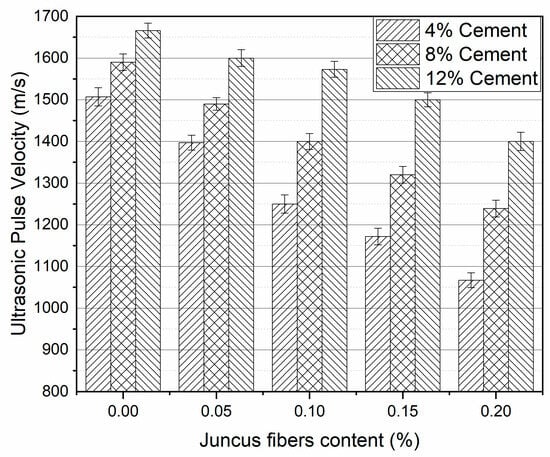
Figure 11.
Ultrasonic pulse velocity as a function of fiber content.
3.1.3. Total Water Absorption
In the vast majority of buildings, water infiltration is inevitable in the construction materials, either through capillary action or immersion. The principal result from the total water absorption (TWA) test is that all the composites remained unaffected and stable after 4 days of immersion in water, as all of the blocks maintained their original shapes and handling capacities without suffering from any significant deterioration, which is an important benefit.
The variation of the total water absorption (TWA) for one day of immersion as a function of cement content for different fiber substitution levels is shown in Figure 12. A decrease in TWA with an increase in cement content can be observed. For blocks without fibers, the value of TWA varied between 14.37% for 4% cement and 12% for blocks containing 12% cement. This corresponded to approximately 19%, which can be attributed to the capacity of cement to fill voids and reduce the porosity between soil particles and fibers, and then decrease the infiltration of water into the composite.
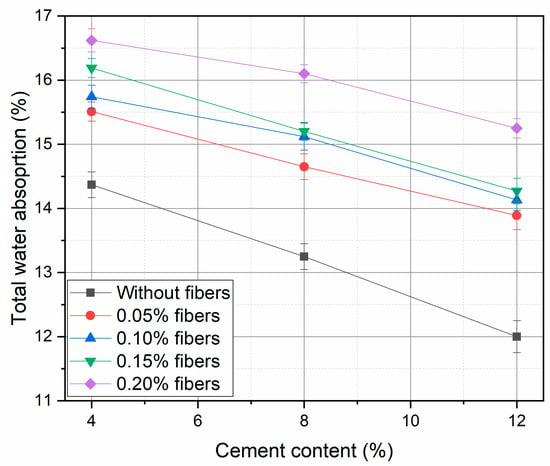
Figure 12.
Effect of cement content and fiber replacement on the total water absorption after one day of immersion.
The evolution of TWA as a function of immersion time is presented in Figure 13. Based on the obtained results, the specimens without fibers display less TWA than blocks reinforced with fibers. It is crucial to note that the majority of water was retained during the first two days, while over the following two days, the evolution of TWA was insignificant, considering that the increase in its value did not surpass 2% for all of the compositions. Moreover, it should be noted that the introduction of fibers increases the TWA, which means that there is more infiltration of water into the specimens. This behavior could be explained by the capacity of fibers to absorb water, which is related to their hydrophilic constitution composed mainly of cellulose and hemicellulose and also their porous network structure.
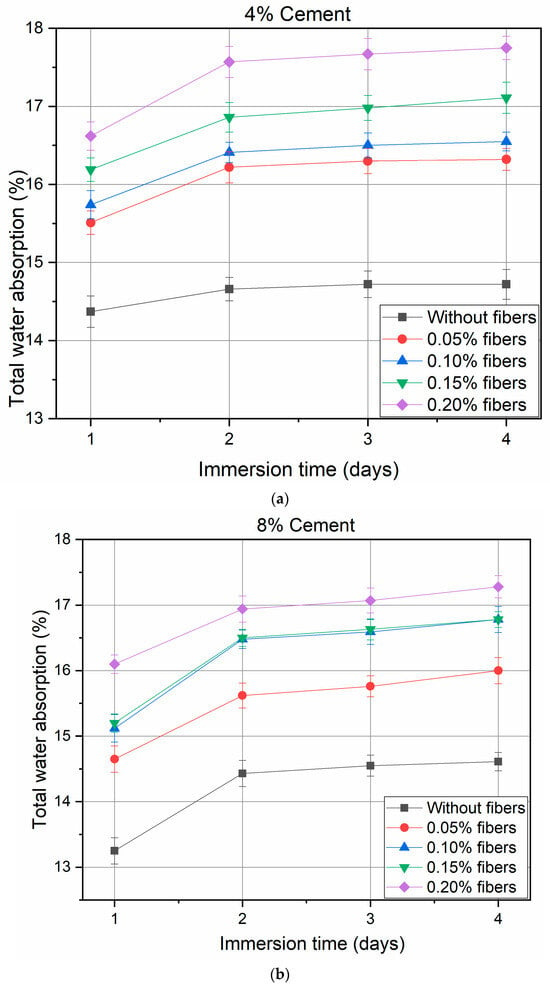
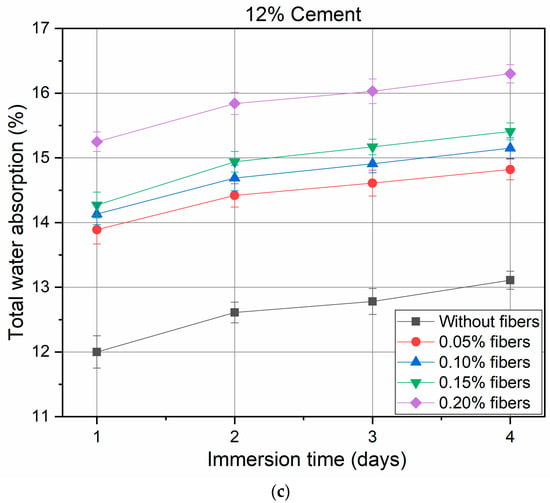
Figure 13.
Total water absorption of composites as a function of immersion time for (a) 4% cement; (b) 8% cement; (c) 12% cement.
3.1.4. Capillarity Coefficient
The variation in the capillarity absorption coefficient (CAC) of the CEBs as a function of the fiber and cement content is shown in Figure 14. It was clearly observed that all the composite materials had a CAC under 20 g/cm2·min1/2, which corresponds essentially to blocks with weak capillarity according to the XP P 13 901 Standard [41]. Also, it can be seen that the increase in fiber content leads to an increase in the value of CAC regardless of the cement content. This behavior can be attributed on the capacity of fibers to absorb and retain more water, and also to the fact that Juncus fibers have more pores than the soil–cement matrix. However, as the cement content increases, the CAC decreases, and its value is lower with a higher binder percentage. Therefore, the obtained results confirm that stabilized compressed earth blocks exhibit insensitivity to water and highlight their suitability for construction applications where resistance to water is crucial. These results are probably due to the capacity of cement to fill the void volume in the sample and thus reduce the number of pores between grains particles and fibers, as well as being due to the great compactness of the CEBs due to the application of 10 MPa of compaction pressure. This trends are in agreement with previous findings [25].
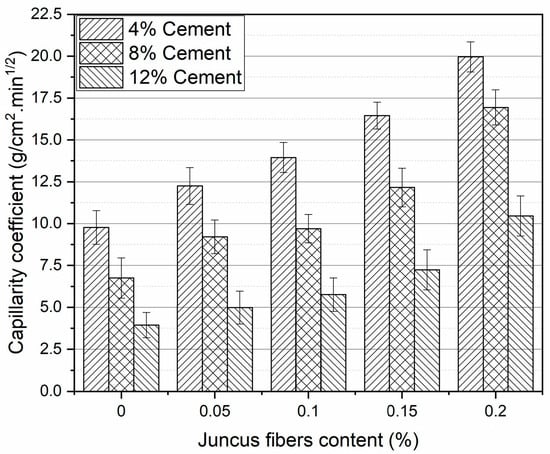
Figure 14.
Effect of varying Juncus fiber contents on the capillarity coefficient of CEBs stabilized with different percentages of cement.
3.2. Compressive Strength
The compressive strength of CEBs is influenced by complex interactions between many factors, including the soil type, fiber type and quantity, production method and compaction pressure. Moisture content holds a pivotal role in this matrix, exerting significant influence on these parameters. It affects the workability of CEBs during mixing, the effectiveness of compaction, the strength of bonds formed between particles and stabilizers, and the progression of the curing process. To understand the behavior of CEBs across varying moisture conditions, it is necessary to conduct both dry and wet compressive strength testing. Dry testing describes the strength of CEBs when completely devoid of moisture, while the wet testing reproduces conditions in which moisture is present during use or exposure to environmental situations. The following sections summarize the obtained results of compressive strength tests performed on the block in both dry and wet conditions.
3.2.1. Dry Compressive Strength
The evolution of dry compressive strength (DCS) as a function of fiber content for different cement content is illustrated in Figure 15. From the obtained results, it can be observed that for each cement content, the incorporation of fibers leads to a decrease in DCS for all the specimens tested, compared to the composite without fibers, and the highest value corresponds to the sample with a cement content of 12% and without fibers, whereas the lowest value corresponds to the sample with a cement content of 4% and a fiber percentage of 0.2%. The graph shows clearly that an increase in the fiber ratio decreases the compressive strength. The decrease in strength between earth blocks with 0.2% fiber reinforcement and earth blocks without fibers is 10%, 15% and 17%, respectively, for 4%, 8% and 12% cement. Consequently, the incorporation of JF has a negative effect on DCS. Figure 15 shows also that the DCS increases with an increasing cement content, e.g., the average value of DCS for the unreinforced blocks is 7.16 MPa, 9.11 MPa, and 11.08 MPa for 4%, 8%, and 12% cement, respectively. The obtained results are in good agreement with previous work from the literature on the influence of cement content on the strength of CEBs filled with date palm fibers. This behavior was noticed by Taalah et al. [12], where similar correlations between cement content and DCS were highlighted. They reported in their study that the DCS reached average values of 7.5 MPa, 9.75 MPa, and 12.2 MPa for 5%, 6,5%, and 8% cement contents, respectively. This finding is also in agreement with the finding of Bahar et al. They concluded that the increase in cement from 4% to 12% led to an increase in DCS from 2.2 MPa to 5.00 MPa and that the better result of 6.20 MPa corresponded to 20% cement stabilization for the unreinforced CEBs [25]. On the other side, and based on our findings, the decrease in compressive strength for fiber addition could be explained by the low stiffness of JF, compared to earth–cement materials. This behavior has been highlighted by previous works [15,52,53]. It was noticed that the incorporation of fibers increases the void network in the blocks, which is the main factor leading to decreased DCS. Moreover, the weak interfacial bond between fibers and the matrix decreases the mechanical performance. Also, the non-homogeneous dispersion of fibers during the preparation of blocks related to their baling effects leads to lower compressive strength. It should be mentioned that the fractures are initiated around the surface of the fibers when the CEB is loaded, which highly accelerates the failure of the composite. Overall, it must be concluded that, in spite of this reduction in strength, the values found for DCS were very satisfactory, since it is recommended that the dry strength for CEBs be superior to 2.4 MPa at 28 days according to Houben et al. [54].
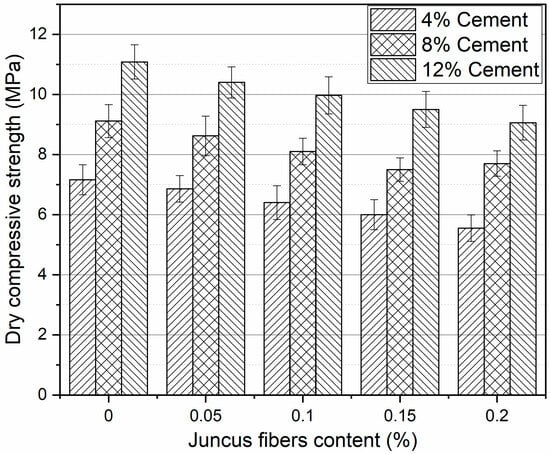
Figure 15.
Result of dry compressive strength according to the fiber content.
3.2.2. Wet Compressive Strength
The influence of fiber content for different cement ratios on the wet compressive strength (WCS) is shown in Figure 16. It can be observed that the incorporation of fibers to the composite decreases its WCS. The lowest value corresponds to the sample with a fiber content of 0.2% and a cement content of 4%, while the highest one was obtained for the sample with 12% cement without fibers. It can be noticed that the reduction in WCS for all earth blocks ranged between 5% and 25% and the values of WCS in non-filled samples were 4.63 MPa, 6.00 MPa and 7.63 MPa for 4%, 8% and 12% of cement, respectively. Moreover, the average difference between dry strength and wet strength is about 58% for 4% cement, 54% for 8% cement and 50% for 12% cement, which indicates that the increase in cement content leads to a reduction in the fractional difference between DCS and WCS. The obtained results confirm the highlights of other studies which noted that the most economical way to increase the WCS of blocks is to increase the stabilizer content [12,55]. This finding is in agreement with a previous study from the literature on the influence of cement on the WCS of CEBs reinforced with date palm fibers. The same trend was reported by Taalah et al. [12]. They reported in their research work that WCS reached average values of 4.5 MPa, 6.31 MPa, and 8.5 MPa for 5%, 6,5%, and 8% cement contents, respectively. This result is also in agreement with the result of Bahar et al. They highlighted that the increase in cement content from 4% to 12% led to an increase in WCS from 1.30 MPa to 2.25 MPa, and that the highest value of 2.85 MPa corresponded to 20% cement stabilization for the unfilled CEBs [25]. Figure 17 shows that the highest (DCS/WCS) ratio, equal to 1.62, corresponds to the 4% cement and 0.15% fibers. In addition, it has been recommended by Houben et al. that the DCS/WCS ratio should be less than 2 [54]. The findings of this work are well within this limit.
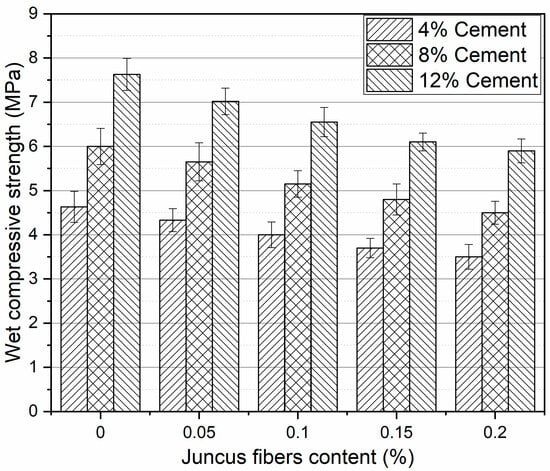
Figure 16.
Results of wet compressive strength according to the fiber content.
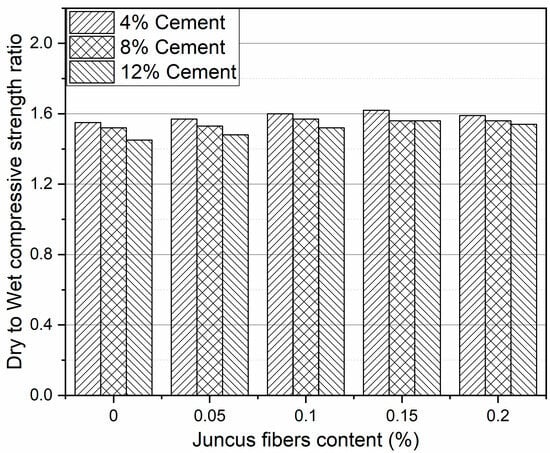
Figure 17.
Dry to wet ratio of the compressive strength of CEBs as a function of the fiber content.
3.3. Thermal Properties
Thermal Conductivity
The thermal conductivity is considered as an important index of masonry insulation, which is why it was investigated in this study.
Figure 18 depicts the thermal conductivity results as obtained for different fiber contents and for three cement contents. From the graph, it can be noticed that the increase in cement content leads to a slight increase in the value of thermal conductivity. The effect of JF content on thermal conductivity is shown in Figure 18. The values of thermal conductivity ranged between 0.2465 W/m·K and 0.4350 W/m·K. The highest value corresponds to the sample with a cement content of 12% without fibers, whereas the lowest value corresponds to the sample with a cement content of 4% and a fiber content of 0.2%. The graph indicates clearly that an increase in fiber content leads to a decrease in the value of thermal conductivity. In comparison to the non-reinforced blocks, the thermal conductivity of CEBs reinforced with 0.05%, 0.10%, 0.15% and 0.20% Juncus fibers and stabilized with 12% cement was 16.6%, 20.40%, 25.4% and 34.7% lower, respectively. These results could be explained, on the one hand, by the increase in blocks’ porosity with incorporation of JF, making the CEBs more insulating, and on the other hand, the insulating effect of Juncus fibers, since they have a low thermal conductivity of 0.0756 W/m·K in comparison to the earth–cement matrix. It is clear from these findings that the reduced thermal conductivity of JF produces less conductive blocks. These findings are consistent with the results reported by several researchers [56,57,58] in their works conducted on the incorporation of vegetable fibers into earth blocks. For example, the research work carried out by Garrouri et al. on earth composites reinforced with alfa fibers of different contents (0%, 7%, 11% and 15% vol) identified a decrease in thermal conductivity of approximately 13.1% [27].
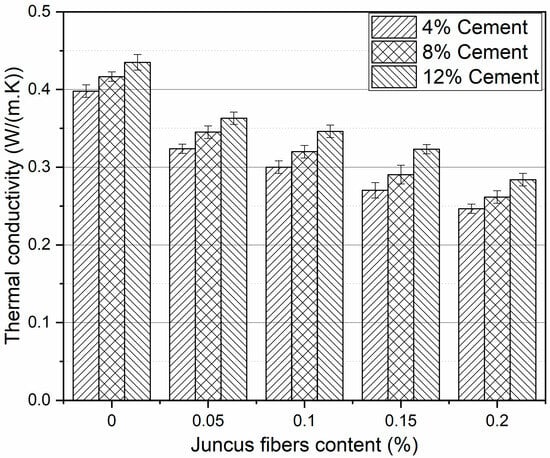
Figure 18.
Thermal conductivity of CEB vs. fiber content.
3.4. Durability Properties
The durability of CEBs was also assessed through their resistance to dry abrasion and to water erosion.
3.4.1. Dry Abrasion Resistance
Figure 19a illustrates the variation in the abrasion resistance coefficient (ARC) as a function of Juncus fiber content. The higher the ARC of the block, the greater its durability performance in terms of abrasion resistance. Three specimens were tested for each formulation. As expected, the increase in cement content leads to an increase in the ARC, meaning that the stabilization has a positive influence on the abrasion resistance. The block with a high content of fibers (0.2%) and a low content of cement (4%) had the lowest value of ARC, 2.432 cm2·g−1, whereas the highest value was 8.182 cm2·g−1, corresponding to the block a 12% cement content without fibers. For the same content of cement, it can be noticed that the addition of JF slightly decreases the abrasion resistance. This can be due to the morphology of Juncus fibers, characterized by a smooth external surface, contributing to weakened bonding between the fibers and the matrix. It can be concluded that the higher the compressive strength, the better the durability of the block. Figure 19b displays the samples after being subjected to abrasion tests.
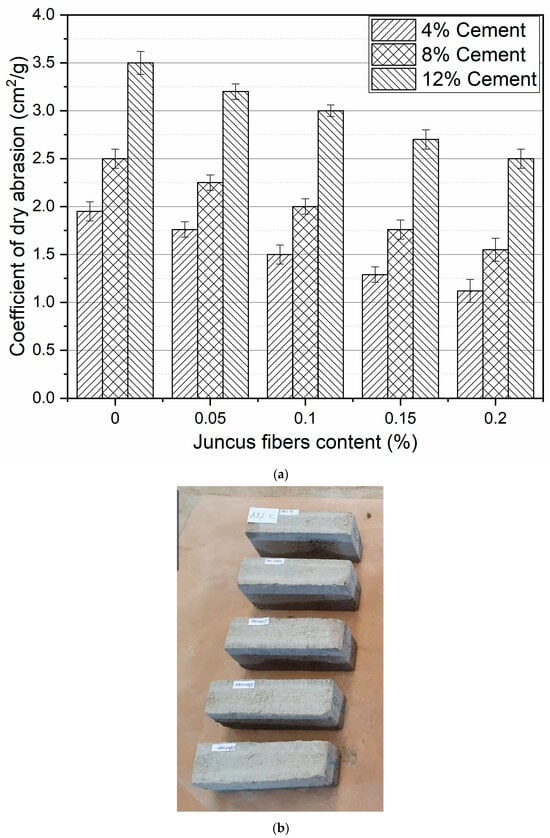
Figure 19.
(a) Effect of fiber content on the abrasion coefficient of CEBs stabilized with different percentages of cement, (b) CEBs after abrasion test.
3.4.2. Erosion Resistance
The durability of earth blocks was also assessed via their resistance to water erosion, in accordance with New Zealand Standard NZS 4298 [47]. It should be noted that the resistance to erosion decreased with the increase in erosion depth according to the mentioned standard. Figure 20 depicts the erosion depth of the four samples tested for each formulation. As can be noticed in this figure, the water did not create any surface deterioration for all samples, which means that this method of stabilization of CEB is greatly efficient in its resistance to water erosion. All the tested bricks had an erosive depth inferior to 5 mm, which corresponds to an erodibility index lower than class 3, allowing us to classify the blocks as slightly erosive materials, and thus satisfying the requirement of NZS [47].
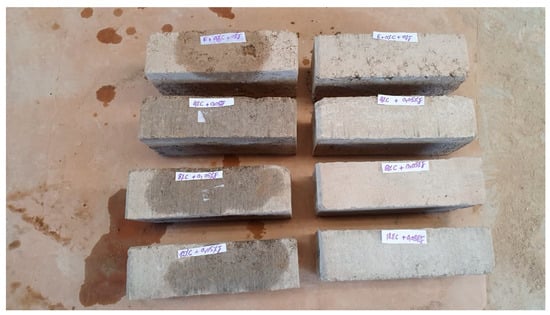
Figure 20.
CEBs after being tested for erosion resistance.
This result shows also that the stabilization of earth blocks with cement increases its erosion resistance. Moreover, the higher the content of cement, the better the erosion resistance. Based on the visual perception throughout this experimental test, the good compactness and cohesion between the cement and soil with a low content of fibers seems to be the main reason for the good performance of this composite material in terms of the erosion resistance. The cement’s hydration reaction with the matrix contributes to reducing the void network inside the mixture by binding earth particles to fibers and then protecting the block from the infiltration of water. These findings of the erosion test show that the composite developed in this study can satisfy the requirements of this building material. This is highly crucial, since the durability of CEBs is as important as their mechanical strength because of their masonry applications and the external loading that is applied during their service life.
4. Conclusions
In this paper, we studied the effect of Juncus fiber content and Portland cement stabilization on the physical, mechanical, thermal and durability properties of compressed earth blocks. According to the experimental analysis, the following conclusions could be drawn:
- The apparent density of the CEB containing 0.2% JF was reduced by approximately 11% in comparison to the CEB composite without fibers, regardless of the Portland cement percentage.
- The impact of JF on the ultrasonic pulse velocity was favorable to promote sound insulation characteristics and damping vibration, owing to the reduction in its value by up to 40% for 4% cement stabilization reinforced with 0.2% fiber content.
- Decreasing the JF content and increasing the cement percentage decreased the total water absorption and capillarity coefficient of the CEBs.
- The incorporation of JF from 0 to 0.2% results in a moderate decrease in the compressive strength of CEBs. Meanwhile, increasing the Portland cement content leads to an increase in the wet and dry compressive strength.
- Better findings for the thermal conductivity were highlighted for the CEB with a 0.2% fiber content and stabilized with 4% cement.
- The durability criteria were respected based on the results of the experimental tests of resistance to erosion and abrasion.
In conclusion, these results lead us to conclude that the combination of Juncus fibers as a reinforcement and Portland cement as a stabilizer allows us to obtain a CEB composite with good properties, which can provide safe, durable, and comfortable building materials.
Author Contributions
R.S.: Conceptualization, Investigation, Visualisation, Methodology, Testing, Writing original draft, Writing—Review and editing. H.K.: Conceptualization, Supervision, Validation, Writing—Review and Editing. M.B.: Conceptualization, Supervision, Validation, Writing—Review and Editing. All authors have read and agreed to the published version of the manuscript.
Funding
This research received no external funding.
Institutional Review Board Statement
Not applicable.
Informed Consent Statement
Not applicable.
Data Availability Statement
The data presented in this study are available on request from the corresponding author. The data are not publicly available due to privacy.
Acknowledgments
The authors gratefully acknowledge Cadi Ayyad University and CAC of Cadi Ayyad University for their support.
Conflicts of Interest
The authors declare no conflict of interest.
References
- Ness, D.A.; Xing, K. Toward a Resource-Efficient Built Environment: A Literature Review and Conceptual Model. J. Ind. Ecol. 2017, 21, 572–592. [Google Scholar] [CrossRef]
- Danso, H.; Martinson, D.B.; Ali, M.; Williams, J.B. Physical, mechanical and durability properties of soil building blocks reinforced with natural fibres. Constr. Build. Mater. 2015, 101, 797–809. [Google Scholar] [CrossRef]
- Mateus, R.; Fernandes, J.; Teixeira, E.R. Environmental Life Cycle Analysis of Earthen Building Materials; Elsevier: Amsterdam, The Netherlands, 2019. [Google Scholar]
- Minke, G. Building with earth. In Building with Earth; Birkhäuser: Basel, Switzerland, 2013. [Google Scholar]
- Islam, M.S.; Elahi, T.E.; Shahriar, A.R.; Nahar, K.; Hossain, T.R. Strength and Durability Characteristics of Cement-Sand Stabilized Earth Blocks. J. Mater. Civ. Eng. 2020, 32, 04020087. [Google Scholar] [CrossRef]
- Alam, I.; Naseer, A.; Shah, A. Economical stabilization of clay for earth buildings construction in rainy and flood prone areas. Constr. Build. Mater. 2015, 77, 154–159. [Google Scholar] [CrossRef]
- Arrigoni, A.; Beckett, C.; Ciancio, D.; Dotelli, G. Life cycle analysis of environmental impact vs. durability of stabilised rammed earth. Constr. Build. Mater. 2017, 142, 128–136. [Google Scholar] [CrossRef]
- Burroughs, S. Recommendations for the selection, stabilization, and compaction of soil for rammed earth wall construction. J. Green Build. 2010, 5, 101–114. [Google Scholar] [CrossRef]
- Eires, R.; Camões, A.; Jalali, S. Enhancing water resistance of earthen buildings with quicklime and oil. J. Clean. Prod. 2017, 142, 3281–3292. [Google Scholar] [CrossRef]
- Abhilash, H.N.; Walker, P.; Reddy, B.V.V.; Heath, A.; Maskell, D. Compressive Strength of Novel Alkali-Activated Stabilized Earth Materials Incorporating Solid Wastes. J. Mater. Civ. Eng. 2020, 32, 04020118. [Google Scholar] [CrossRef]
- Mostafa, M.; Uddin, N. Experimental analysis of Compressed Earth Block (CEB) with banana fibers resisting flexural and compression forces. Case Stud. Constr. Mater. 2016, 5, 53–63. [Google Scholar] [CrossRef]
- Taallah, B.; Guettala, A.; Guettala, S.; Kriker, A. Mechanical properties and hygroscopicity behavior of compressed earth block filled by date palm fibers. Constr. Build. Mater. 2014, 59, 161–168. [Google Scholar] [CrossRef]
- Zak, P.; Ashour, T.; Korjenic, A.; Korjenic, S.; Wu, W. The influence of natural reinforcement fibers, gypsum and cement on compressive strength of earth bricks materials. Constr. Build. Mater. 2016, 106, 179–188. [Google Scholar] [CrossRef]
- Nagaraj, H.; Sravan, M.; Arun, T.; Jagadish, K. Role of lime with cement in long-term strength of Compressed Stabilized Earth Blocks. Int. J. Sustain. Built Environ. 2014, 3, 54–61. [Google Scholar] [CrossRef]
- Khedari, J.; Watsanasathaporn, P.; Hirunlabh, J. Development of fibre-based soil-cement block with low thermal conductivity. Cem. Concr. Compos. 2005, 27, 111–116. [Google Scholar] [CrossRef]
- Kriker, A.; Debicki, G.; Bali, A.; Khenfer, M.; Chabannet, M. Mechanical properties of date palm fibres and concrete reinforced with date palm fibres in hot-dry climate. Cem. Concr. Compos. 2005, 27, 554–564. [Google Scholar] [CrossRef]
- Taallah, B.; Guettala, A. The mechanical and physical properties of compressed earth block stabilized with lime and filled with untreated and alkali-treated date palm fibers. Constr. Build. Mater. 2016, 104, 52–62. [Google Scholar] [CrossRef]
- Saghrouni, Z.; Baillis, D.; Jemni, A. Composites based on Juncus maritimus fibers for building insulation. Cem. Concr. Compos. 2019, 106, 103474. [Google Scholar] [CrossRef]
- Limam, A.; Zerizer, A.; Quenard, D.; Sallee, H.; Chenak, A. Experimental thermal characterization of bio-based materials (Aleppo Pine wood, cork and their composites) for building insulation. Energy Build. 2016, 116, 89–95. [Google Scholar] [CrossRef]
- Panesar, D.; Shindman, B. The mechanical, transport and thermal properties of mortar and concrete containing waste cork. Cem. Concr. Compos. 2012, 34, 982–992. [Google Scholar] [CrossRef]
- Adam, E.; Jones, P. Thermophysical properties of stabilised soil building blocks. Build. Environ. 1995, 30, 245–253. [Google Scholar] [CrossRef]
- Zare, P.; Narani, S.S.; Abbaspour, M.; Fahimifar, A.; Hosseini, S.M.M.M.; Zare, P. Experimental investigation of non-stabilized and cement-stabilized rammed earth reinforcement by Waste Tire Textile Fibers (WTTFs). Constr. Build. Mater. 2020, 260, 120432. [Google Scholar] [CrossRef]
- Segetin, M.; Jayaraman, K.; Xu, X. Harakeke reinforcement of soil–cement building materials: Manufacturability and properties. Build. Environ. 2007, 42, 3066–3079. [Google Scholar] [CrossRef]
- Sujatha, E.R.; Devi, S.S. Reinforced soil blocks: Viable option for low cost building units. Constr. Build. Mater. 2018, 189, 1124–1133. [Google Scholar] [CrossRef]
- Bahar, R.; Benazzoug, M.; Kenai, S. Performance of compacted cement-stabilised soil. Cem. Concr. Compos. 2004, 26, 811–820. [Google Scholar] [CrossRef]
- Zhang, L.; Gustavsen, A.; Jelle, B.P.; Yang, L.; Gao, T.; Wang, Y. Thermal conductivity of cement stabilized earth blocks. Constr. Build. Mater. 2017, 151, 504–511. [Google Scholar] [CrossRef]
- Garrouri, S.; Lakhal, W.; Benazzouk, A.; Sediki, E. Potential use of Alfa fibers in construction material: Physico-mechanical and thermal characterisation of reinforced specimen. Constr. Build. Mater. 2022, 342, 127787. [Google Scholar] [CrossRef]
- Williams, J.; Lawrence, M.; Walker, P. A method for the assessment of the internal structure of bio-aggregate concretes. Constr. Build. Mater. 2016, 116, 45–51. [Google Scholar] [CrossRef]
- Achenza, M.; Fenu, L. On earth stabilization with natural polymers for earth masonry construction. Mater. Struct. 2006, 39, 21–27. [Google Scholar] [CrossRef]
- Islam, M.S.; Iwashita, K. Earthquake resistance of adobe reinforced by low cost traditional materials. J. Nat. Disaster Sci. 2010, 32, 1–21. [Google Scholar] [CrossRef]
- Gandia, R.M.; Gomes, F.C.; Corrêa, A.A.R.; Rodrigues, M.C.; Mendes, R.F. Physical, mechanical and thermal behavior of adobe stabilized with glass fiber reinforced polymer waste. Constr. Build. Mater. 2019, 222, 168–182. [Google Scholar] [CrossRef]
- Binici, H.; Aksogan, O.; Bodur, M.N.; Akca, E.; Kapur, S. Thermal isolation and mechanical properties of fibre reinforced mud bricks as wall materials. Constr. Build. Mater. 2006, 21, 901–906. [Google Scholar] [CrossRef]
- Baram, S.; Ronen, Z.; Kurtzman, D.; Külls, C.; Dahan, O. Desiccation-crack-induced salinization in deep clay sediment. Hydrol. Earth Syst. Sci. 2013, 17, 1533–1545. [Google Scholar] [CrossRef]
- Guo, H.; Bao, A.; Liu, T.; Jiapaer, G.; Ndayisaba, F.; Jiang, L.; Kurban, A.; De Maeyer, P. Spatial and temporal characteristics of droughts in Central Asia during 1966–2015. Sci. Total. Environ. 2018, 624, 1523–1538. [Google Scholar] [CrossRef] [PubMed]
- An, R.; Wang, Y.; Zhang, X.; Chen, C.; Liu, X.; Cai, S. Quantitative characterization of drying-induced cracks and permeability of granite residual soil using micron-sized X-ray computed tomography. Sci. Total. Environ. 2023, 876, 163213. [Google Scholar] [CrossRef] [PubMed]
- ASTM D6913-04; Standard Test Method for Particle-Size Analysis of Soils. ASTM: West Conshohocken, PA, USA, 2007.
- D4318-10; Standard Test Methods for Liquid Limit, Plastic Limit, and Plasticity Index of Soils. ASTM: West Conshohocken, PA, USA, 2010.
- D698-12; Standard Test Methods for Laboratory Compaction Characteristics of Soil Using Standard Effort (12 400 Ft-lbf/ft3 (600 KN-m/m3)) 1. ASTM International: West Conshohocken, PA, USA, 2007.
- Standard IMANOR: NM 13.1.178; Mesure de la Quantité et de L’activité de la Fraction Argileuse. Détermination de la Valeur de Bleu de Méthylène d’un Sol Par L’essai à la Tache, en Large Concordance Avec la NF P94-068:1998. Institut Marocain de Normalisation: Rabat, Morocco, 2018.
- P13-901; Blocs de Terre Comprimée Pour Murs et Cloisons, Définitions-Spécifications-Méthodes d’essais-Conditions de Reception. AFNor: St.-Denis, France, 2001.
- Ribeiro, H.; Almeida, C.M.R.; Mucha, A.P.; Teixeira, C.; Bordalo, A.A. Influence of natural rhizosediments characteristics on hydrocarbons degradation potential of microorganisms associated to Juncus maritimus roots. Int. Biodeterior. Biodegrad. 2012, 84, 86–96. [Google Scholar] [CrossRef]
- Martínez-Sánchez, J.; Conesa, E.; Vicente, M.; Jiménez, A.; Franco, J. Germination responses of Juncus acutus (Juncaceae) and Schoenus nigricans (Cyperaceae) to light and temperature. J. Arid. Environ. 2006, 66, 187–191. [Google Scholar] [CrossRef]
- Naili, H.; Jelidi, A.; Limam, O.; Khiari, R. Extraction process optimization of Juncus plant fibers for its use in a green composite. Ind. Crop. Prod. 2017, 107, 172–183. [Google Scholar] [CrossRef]
- P18-418; Béton-Auscultation sonique. Mes. Temps Propag. D’ondes Soniques Dans Béton Norm. Afnor EDITIONS: Saint-Denis, France, 1989; pp. 1–12.
- ASTM, C. 1557-03; Standard Test Method for Tensile Strength and Young’s Modulus of Fibers. ASTM International: West Conshohochen, PA, USA, 2003.
- NZS 4298; Materials and Workmanship for Earth Buildings. Standards New Zealand: Wellington, New Zealand, 1998.
- Bouchefra, I.; EL Bichri, F.Z.; Chehouani, H.; Benhamou, B. Mechanical and thermophysical properties of compressed earth brick rienforced by raw and treated doum fibers. Constr. Build. Mater. 2021, 318, 126031. [Google Scholar] [CrossRef]
- Khoudja, D.; Taallah, B.; Izemmouren, O.; Aggoun, S.; Herihiri, O.; Guettala, A. Mechanical and thermophysical properties of raw earth bricks incorporating date palm waste. Constr. Build. Mater. 2021, 270, 121824. [Google Scholar] [CrossRef]
- Aamr-Daya, E.; Langlet, T.; Benazzouk, A.; Quéneudec, M. Feasibility study of lightweight cement composite containing flax by-product particles: Physico-mechanical properties. Cem. Concr. Compos. 2008, 30, 957–963. [Google Scholar] [CrossRef]
- Belakroum, R.; Gherfi, A.; Bouchema, K.; Gharbi, A.; Kerboua, Y.; Kadja, M.; Maalouf, C.; Mai, T.; El Wakil, N.; Lachi, M. Hygric buffer and acoustic absorption of new building insulation materials based on date palm fibers. J. Build. Eng. 2017, 12, 132–139. [Google Scholar] [CrossRef]
- Mebarkia, R.; Bouzeroura, M.; Chelouah, N. Study of the effect of cement kiln dust on the mechanical, thermal and durability properties of compressed earth blocks. Constr. Build. Mater. 2022, 349, 128707. [Google Scholar] [CrossRef]
- MacVicar, R.; Matuana, L.; Balatinecz, J. Aging mechanisms in cellulose fiber reinforced cement composites. Cem. Concr. Compos. 1999, 21, 189–196. [Google Scholar] [CrossRef]
- Omrani, H.; Hassini, L.; Benazzouk, A.; Beji, H.; Elcafsi, A. Elaboration and characterization of clay-sand composite based on Juncus acutus fibers. Constr. Build. Mater. 2020, 238, 117712. [Google Scholar] [CrossRef]
- Houben, H.; Rigassi, V.; Garnier, P. Blocs de Terre Comprimée: Équipements de Production; CRATerre: Brussels, Belgium, 1996; Volume 149. [Google Scholar]
- Lunt, M.G. Stabilised soil blocks for building. In Building in Hot Climates: A Selection of Overseas Building Notes; Building Research Establishment: Watford, UK, 1980; pp. 127–144. [Google Scholar]
- Mellaikhafi, A.; Ouakarrouch, M.; Benallel, A.; Tilioua, A.; Ettakni, M.; Babaoui, A.; Garoum, M.; Hamdi, M.A.A. Characterization and thermal performance assessment of earthen adobes and walls additive with different date palm fibers. Case Stud. Constr. Mater. 2021, 15, e00693. [Google Scholar] [CrossRef]
- Ouedraogo, M.; Dao, K.; Millogo, Y.; Aubert, J.-E.; Messan, A.; Seynou, M.; Zerbo, L.; Gomina, M. Physical, thermal and mechanical properties of adobes stabilized with fonio (Digitaria exilis) straw. J. Build. Eng. 2019, 23, 250–258. [Google Scholar] [CrossRef]
- Cherki, A.; Khabbazi, A.; Remy, B.; Baillis, D. Granular cork content dependence of thermal diffusivity, thermal conductivity and heat capacity of the composite material/granular cork bound with plaster. Energy Procedia 2013, 42, 83–92. [Google Scholar] [CrossRef]
Disclaimer/Publisher’s Note: The statements, opinions and data contained in all publications are solely those of the individual author(s) and contributor(s) and not of MDPI and/or the editor(s). MDPI and/or the editor(s) disclaim responsibility for any injury to people or property resulting from any ideas, methods, instructions or products referred to in the content. |
© 2024 by the authors. Licensee MDPI, Basel, Switzerland. This article is an open access article distributed under the terms and conditions of the Creative Commons Attribution (CC BY) license (https://creativecommons.org/licenses/by/4.0/).